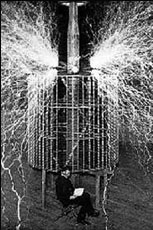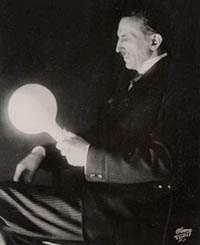Free Energy
From the beginning of A. K. Brown's and George Westinghouse's fortuitous partnerships with Tesla, the inventor was at work on
other projects above and beyond the AC dynamo. Able to devote himself to the unhindered realization of his countless ideas, he
would later recall these years of his life as "little short of continuous rapture."
Tesla's New York laboratory was a hive of continuous activity, with a small staff of assistants working solely from their employer's
verbal instructions. His distaste for putting ideas down on paper, coupled with his tendency to get bored with a completed invention
and move on to the next challenge, led Tesla to toss aside a large number of creations that he never even bothered to patent. Once,
when exhaustion left Tesla in a state of temporary amnesia, his assistant filed for patents on many of the unregistered inventions on
Tesla's behalf, and had the master sign the papers while still incapacitated. Tesla's shunning of documentation was of some benefit
when fire destroyed the lab in 1895, right after the success at Niagara. The loss was a setback, but not a catastrophic one, since the most valuable of the laboratory's
assets remained intact in Tesla's brain.
 In 1891, Tesla developed the invention by which his name is most commonly known today: the Tesla coil. Simple enough for today's hobbyists and science-fair entrants
to construct in fully functional homemade models, it was nonetheless a remarkable innovation which remains the basis for radios, televisions and other modern means of
wireless communication.
In 1891, Tesla developed the invention by which his name is most commonly known today: the Tesla coil. Simple enough for today's hobbyists and science-fair entrants
to construct in fully functional homemade models, it was nonetheless a remarkable innovation which remains the basis for radios, televisions and other modern means of
wireless communication.
Tesla became known for the lectures at which he demonstrated his inventions and concepts with a theatrical flair. Many attendees were laymen who had little
comprehension of what Tesla said, but were mesmerized by the bolts of lightning that leapt from his ominously humming coils, and the unwired light bulbs that lit at the
touch of Tesla's hand. These spectacular displays led Tesla to be popularly regarded as some sort of magician -- a title that was bestowed not in ridicule, but in awe.
The wireless transmission of energy would become the ultimate pursuit of Tesla's career. He discovered that a vacuum tube held in proximity to a Tesla coil would burst
into illumination, without wires, without even a filament inside the glowing tube. Electrical resonance was the key to this discovery. By determining the frequency of the
needed electrical current, Tesla was able to turn a series of different lights on and off selectively, from yards away. He had just become an American citizen in 1891, and
this new technology was to be his gift of thanks to his adoptive country: a means of transmitting energy instantly, across any distance, through thin air. Free energy for
everyone.
 One of Tesla's assistants reportedly questioned the implications of putting such an energy distribution plan into practice. He wondered what incentive there would be for
the electrical power establishment to begin giving away its goods for free, and whether Tesla could possibly be "allowed" to introduce such an arrangement. The presence
of such doubts enraged Tesla, who was convinced, somewhat naively, that his plan would be accepted simply because it was the right thing to do.
One of Tesla's assistants reportedly questioned the implications of putting such an energy distribution plan into practice. He wondered what incentive there would be for
the electrical power establishment to begin giving away its goods for free, and whether Tesla could possibly be "allowed" to introduce such an arrangement. The presence
of such doubts enraged Tesla, who was convinced, somewhat naively, that his plan would be accepted simply because it was the right thing to do.
As the years passed, Tesla's vision of wireless energy grew even grander in scope. He solved one of the problems implicit in his first theory, which was that
transmission of power through air over long distances would result in a significant loss of energy. Rather than using air as a medium, he decided to send energy through
the ground. This makes little sense in conventional electrical terms, whereby the earth's surface is regarded as, literally, "the ground" -- a sinkhole used for discharging
excess current from a conductor. But Tesla found that if it were charged highly enough, the ground could become the conductor itself. In this way, the entire planet could
be transformed into a colossal electric transmitter.
In 1899, as logistics prevented him from conducting the necessary experiments within the confines of New York City, Tesla headed west. A Colorado attorney named
Leonard Curtis, who had previously defended Tesla in court, offered to help Tesla set up a testing facility in Colorado Springs. Curtis was also an officer of the local
power company, and provided electricity to Tesla at no cost.
Tesla and his assistants built a one-of-a-kind laboratory on the outskirts of town, which looked like a large barn topped by a 180-foot metal tower. This was Tesla's
"magnifying transformer," which he called the greatest of his inventions.
The townspeople of Colorado Springs were naturally curious about what this great inventor was up to, and respected the signs around the perimeter of the compound
reading "KEEP OUT -- GREAT DANGER!" Still, they soon felt the effects of Tesla's apparatus. Sparks leapt from the ground as people walked the streets, singeing
their feet through their shoes. The grass around the Tesla building glowed with a faint blue light. Metal objects held near fire hydrants would draw miniature lightning
bolts from several inches away. Switched-off light bulbs within 100 feet of the tower spontaneously lit.
And Tesla was only tuning up his equipment. These were the side effects of adjusting the magnifying transformer into perfect resonance with the earth. Once it was
properly calibrated, Tesla was ready to conduct his career's boldest symphony, using the entire planet as his orchestra.
Late one night in the fall of 1899, Tesla fired up his machine at full blast, in hopes of producing a phenomenon he called resonant rise. His tower pumped ten million
volts into the earth's surface. The current raced through the earth at the speed of light, powerful enough to keep from dying out over the course of its journey. When it
reached the opposite side of the planet, it bounced back, like ripples of water returning to their origin. Upon returning, the current was greatly weakened; but Tesla was
sending out a series of pulses which reinforced one another, resulting in a tremendous cumulative effect.
At ground zero, where Tesla and his assistant stood bedazzled, the resonant rise manifested itself in an unearthly display of lightning that still stands as the most powerful
man-made electrical surge in history. The returning current formed an arc of lightning that stretched skyward from Tesla's tower and progressively grew to an incredible
130 feet long. Apocalyptic crashes of thunder were heard twenty-two miles away. Tesla had been concerned that there might be an upper limit to generating resonant
surges, but now he believed the potential was limitless. The demonstration did come to an unexpected halt, but that was because the power surge caused the overloaded
Colorado Springs power generator to burst into flames. Tesla received no further free power from the plant's furious owners.
He returned to New York in search of backing for the global implementation of a resonant energy system. Now cognizant of the business world's inevitable reluctance to
support giving away free energy, Tesla pitched his new project as a means of transmitting communication, rather than electrical power. Decades before the birth of the
Internet, Tesla was envisioning an information superhighway that was a far more sophisticated communication network than the one we use today.
George Westinghouse passed on the idea. Tesla next proposed it to J. P. Morgan, the wealthiest man in America, who had previously declined to finance the inventor.
The idea of a monopoly on world communications intrigued Morgan, and he enabled Tesla to build a new laboratory on Long Island. Named Wardenclyffe, it was to be a
bigger and better version of his Colorado facility.
While Tesla worked on the project, a string of accidents and bad luck struck Wardenclyffe, and he was beginning to run out of money. Morgan's funds and enthusiasm
seemed to evaporate. In a last-ditch effort to keep his investor from deserting him, Tesla revealed to Morgan that his true goal was not to replace the telegraph, but to
replace the conventional transmission of electricity. Morgan responded by withdrawing his support entirely.
Tesla would never get another opportunity to bring free energy to the world.

